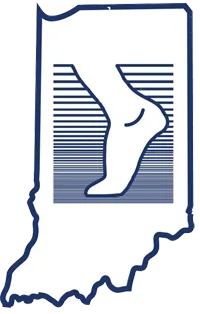May is National Bike Month and there are many ways you can become involved.
The city of Indianapolis has just recently completed the Cultural Trail. In addition Friday May 17th is bike to work day presented by IndyCog. I personally feel the city has done a tremendous job of making itself a more biking friendly center with great accessibility through an ever expanding network of trails. May is a great month to get out and enjoy the trails, whether you are a new cyclist or experienced rider, pavement or mountain biking.
In general, I tend to recommend cycling to my patients. It is an excellent cardiovascular workout, which is fun and can be done independently or with a group. There is also reduced force across many of the joints in the lower extremity and foot. You can do it indoors or out and enjoy a variety of scenery, which is much more pleasant than wiling the time away on a treadmill or elliptical machine.
As you start pedaling, there are a couple foot related issues to consider to improve your performance and reduce the risk of injury. Generally speaking there are two cycling specific injuries which are most common and most annoying.
Forefoot numbness and /or pain is probably the most common chronic cycling related issue we treat. The foot, obviously, is the contact point with the cycling pedal, whether you are using a cleat or a platform pedal. However, most of these problems can be easily addressed. In a 2003 study, cycling shoes with carbon fiber soles/shank were shown to induce more stress under the forefoot. The concept is to create greater transfer of energy through the foot, but this can come at a cost. There are options including nylon in lieu of the carbon fiber and a wider toebox to help alleviate some of these symptoms. Pedals with a wider platform distribute the force better than smaller pedals. Regardless of the platform width, you may still get some discomfort if you cycle greater distances. The repetitive nature of cycling with the foot typically locked into one position can exacerbate these issues. Adjusting your foot position on a platform pedal or changing your cleat position can be a simple solution. You may need to experiment with this or consult a fitting specialist for anything but a minor adjustment can affect your cadence significantly. If you have access to a trailer or roller you may find it most convenient to experiment in this more controlled environment. There are several OTC inserts which are cycling specific which may also address mechanical issues which maybe causing the numbness. If these options fail to address your symptoms, it may be time to visit your friendly neighborhood podiatrist, who also happen to be biomechanical experts!
Biomechanical abnormalities, such as a shorter (or longer) limb, bunions, hammertoes, neuromas, etc can all contribute to the problem and can be addressed with an extra insole in the forefoot (up to 1/4 inch if you have enough volume in the shoe), adding washers/shims between the cleat and the shoe or moving the cleat back on the longer leg's shoe. One of the most common underlying problems is a condition known as: pre-dislocation syndrome, which affects the 2nd metatarsal phalangeal joint. This is the joint at the base of the 2nd toe. It is relatively common to have a longer 2nd toe or longer 2nd metatarsal bone behind the toe, which increases the pressure on this area. This can be further worsened by any mechanical instability or bunion deformity, transferring additional force and pressure across the area. The nature of cycling and the contact point of the foot on the bike pedal or cleat further stresses this area causing pain, swelling and sometimes progressive deformity of the toe. The good news is this can usually be alleviated by icing, NSAIDs, and ROM exercises. If this fails to successfully reduce the symptoms, a functional foot orthosis may be employed to redistribute the forces to a more biomechanically sound position. These can be specifically made to your cycling shoes, with minimal additional weight. Occasionally an injection or surgery may be needed for severe deformity. Specific modifications may be employed for any other structural changes in the foot and ankle and to a lesser extent the knee. Foot orthoses with a forefoot extension can help control excessive internal leg rotation, which can cause knee pain (patello-femoral syndrome/chondromalacia). Keep in mind there are other factors which may contribute to these symptoms such as a seat positioned too low or high, and cycling with too high a gear, can also contribute to knee pain.
Achilles tendon problems are not uncommon with cyclists, particularly those covering a lot of mileage. The covering of the Achilles, known as the paratenon, can become inflamed from the continuous friction and repetitive stresses. Physical therapy, staying in the saddle and using lower gears can help. Stretching and home exercises as well as a proper warm up period will also help reduce this chronic situation. This may unfortunately progress to tendinosis in which there is thickening and scarring of the tendon fibers, which is more likely fail conservative treatment. Sometime surgery is needed and is very helpful at this point.
Follow a couple simple steps and you can avoid most of the overuse injuries associated with cycling and enjoy a great season in the saddle. If you need our assistance with fit, shoes, or biomechanical analysis, we are just a phone call away and ready to help.
